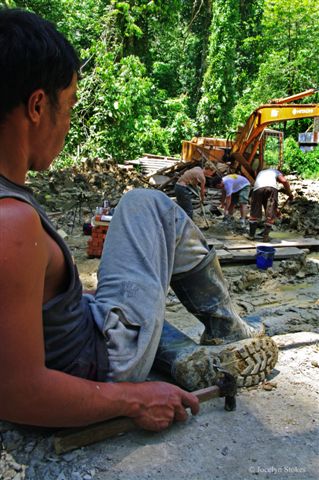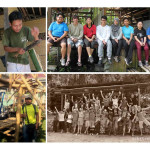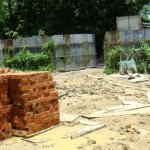Builders: Britain vs. Malaysia
Text and photos by Billy Dunn
When Ian asked me to write a piece for the blog about my first experiences living and working in Sabah, Borneo, I initially thought of the obvious cultural differences; food, drink, climate, wildlife etc. These of course are all very interesting and important…
…but in order to give my own unique view so far on Sabah that would provide something a bit light-hearted to think about, I have decided to write about a topic I experience everyday…builders.
It is interesting to make you aware that this is in fact my first experience of working on a building site. During my working year out from studying Architecture back in the UK I never left the office so my first encounter with working alongside builders has occurred here in Sepilok! Whether this is a good or bad introduction to the daily life of a construction site remains to be seen!
To paint the picture I’m going to compare the general rules and stereotypical habits of builders in the UK to the builders here, who in fact originate from the Philippines.
Imagine this process in Britain; The builders are arranging the reinforcement bars and formwork for the concrete roof tie beams. They would have big, sturdy, steel toe caps boots on, wearing helmets and high visibility vests and standing on a carefully erected scaffolding platform, probably attached to a harness. They would be wearing gloves and would overall be secure in the job they were participating in.
Now imagine this in Sabah; The builder’s protection on their feet (if any) is flip flops. I haven’t actually seen a helmet since I have been here. The only thing they wear on their heads are large sombreros. The scaffolding platform they are clambering up and balancing on top of is swaying with every swing of the hammer they take. The closest thing to a safety harness they have seems to be a cigarette in their mouth as no-one would dare be up there without one. It also seems to help them balance. So imagine a builder two storeys up; he is swinging away at the nails whilst puffing away on his fag and carefully balancing in his flip flops which are almost falling off his feet, all whilst on top of the jelly scaffolding!
So this was my first impression of construction. I initially watched every move with horror waiting for something to go wrong but I have now become fascinated with the way they work.
On a typical British building site there are heavy rules about no children allowed on site. Here, there are not only children on site, but they are actually the builder’s daughters! One of the girls, who can’t be any older than 5, quite freely walks around the nails and bits of stray material, barefoot, beneath the scaffolding. If she gets a little bored she’ll pick up a hammer and start nailing something, all in the proud eye of her father!
In Britain, the use of heavy machinery is a serious responsibility. In Sepilok, on a Sunday afternoon with the family watching and in between using the bucket for distributing concrete to be poured for the tie beams, the excavator becomes a serious piece of fun. The two guys, rather than climb back down the wobbly scaffolding, calmly jump into the bucket and hold on tightly to be dropped and raised spectacularly like a rollercoaster. The driver has his headphones in listening to music by the way, but the smiles on their faces was worth all the safety issues of course.
Welding should be approached using a protective mask as exposure to the glare can damage the eyes. Here, I’m still scratching my eyes in amazement (no pun…) wondering if any welders here can see. One particular welder must enjoy the overall itchy, irritable blind sensation as he sits wearing sun glasses with his face a foot away from the new bear cages being welded.
At home, if we get a spell of bright weather, the typical builder loses his top to expose his pasty white belly and “builders crack.” The radio from the van is blaring out and the Sun Newspaper is being thrown around. All of this is in fact the opposite here. With the constant hot conditions, a majority of the builders like to cover up completely from the sun. This involves long tight sleeves, long skinny jeans and usually a t shirt wrapped around his head with a pair of sunglasses, all in 35 degrees of heat. There are no radios required as the Philippine guys enjoy singing their hearts out whilst on site; we’ve had everything from Janet Jackson to the Beatles.
From all these comparisons there are two characteristics British and Malaysian builders have in common.
The first involves females. It is in fact in the small print of builders’ rights that at any stage should a member of the opposite sex come into sight, then all work can pause. During the construction of the Biogas Digester on site, we had eight female volunteers from Camps International. Before the girls could pick up a brick I realised that the eyes of three sets of builders were directed at them; the guys working directly next to us, a group near the gate working on the new orang-utan nursery and another at the top of the hill. All tools were laid down, wheelbarrows dumped and engines switched off to admire the girls! Unlike the British way of approaching girls, there were no wolf-whistling or sexist comments but simply a calm stare!
The second is to enjoy riding in vans. Any opportunity to hop in the van to go somewhere is gladly received. Here you have the added bonus that more can fit on the back of the truck with one hand holding onto the roof and the other waving goodbye to the girls. The dashboard of your van must also be filled with old newspapers, used drinks cartons and any invoices that were supposed to be given.
Above all I would like to stress that working with the local builders is a pleasure. They always have a smile on their face, will always greet you and say goodbye and will share any English they know with you. Through all the tricky conditions they face, they get on with their work to a high level and all for a very minimal wage. They also gladly get involved with helping the sun bear volunteers when they can see we’re struggling and are happy to share their knowledge and tools.
I will write a sequel to this blog one day once I have experienced all this through the British builder’s perspective!
Related posts








Pingback: Builders: Britain vs. Malaysia | Bornean Sun Bear Conservation
Pingback: Sepilok Poo Burner | Arkitrek
Great blog Bill – that’s what makes what you’re doing so valuable, you’ll be a far better architect for the experience. Wait til you encounter european red tape, you’ll hanker for Sepilok and her real builders!